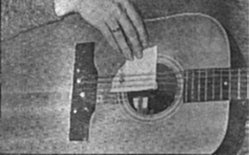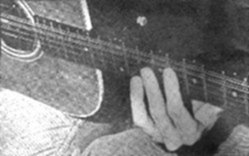Leo Kottke: His Techniques, Guitars, Slide, & Tricks of the Trade
by Gil Podolinsky
Page 3Is this why you approached Bozo Podunavac [see GP, April '77] to build a guitar for you?
I traded one of my guitars for one of his 6-strings because the sound was what I was after. I felt then that if I asked him to build a 12-string, I'd come close to what he did with the 6- string and what I wanted to hear in a 12-string. Now I'm becoming convinced that a 12-string should be built with an adjustable bridge, suspended on a couple of screws, because without one the bridge destroys a lot of sustain. The adjustable bridge increases the amount of attack that you hear.
 |
How much were you involved with Bozo in the construction of the first 12-string he built for you?
I didn't really get involved with the construction. I told him where I'd be pitching it [the E string is pitched two steps lower, to a C] and that I wanted a 2" wide neck. I hadn't decided whether I liked rosewood or mahogany back and sides. I felt that it depends upon who's building it. I did decide on rosewood for this Bozo. On a proper guitar -- that being one that sounds right -- I prefer one that has mahogany rather than rosewood because the note sounds warmer, more apparent, friendly, more musical. That's true of any mahogany guitar, but especially true of the 12-string, and you don't need much of that. Bozo also knew that I liked a cutaway since I play a Martin Conversion that is a 28" cutaway guitar.
Do you plan to add any other Bozo guitars to your present collection?
Bozo recently built me a new 12-string that has a smaller box. The reason why I opted for that is I wanted a 12-string with a faster decay rate. On the 12-string you don't want a lot of ring because it will run into itself.
How do you think the perfect 12-string should sound?
Well, I think a 12-string should sound a little boxy, a little thunky like a 6-string, so when you add the extra six strings it sounds as defined and manageable as a 6-string.
You first asked Bozo for a 2" neck and now you've changed your mind. Why?
Right, I don't want it as wide as I did at first. The first guitar I got from Bozo had a 2" neck, like the Gibson B-45, only with the fingerboard less curved, which makes a big difference. I'm personally in favor of the curve, but again it depends on who's making the instrument. Bozo uses much less of a curve than Gibson so that a 2" neck was a little too wide. We're down to whatever his standard is for a 12-string [about 1 & 7/8"], which is perfectly comfortable. I tend to fool around and experiment with things for the guitar. I really like the B-45 for its adjustable bridge. My favorite repairman, Gary Wagner, who lives in Minneapolis and has since retired, put a graduated nut for each string on that Gibson. Although I really like the tone of the new, smaller bodied Bozo, I may go back to the big bell, which started off as an experiment for me anyway.
When will you start using the smaller Bozo in performance?
I'm in the process of breaking it in, which really means, deciding whether to use a mike or a pickup, but it will probably be a mike. I now have a soundman touring with me and he's getting the guitar out into the room where it's big and fat and loud enough without burying the audience. With his help I hope I can go back to the Bozo with just a mike.
The Gibson B-45 was the first 12-string guitar that you owned, the best you've ever played, and was eventually stolen, leading you to discussions with Gibson in order to build you a prototype of the instrument. What ever become of that?
 |
Is tuning the 12-string a problem?
Yes, it goes out of tune easily. It's very touchy temperature-wise. All of the pairs of strings are slightly out anyhow, especially when fretted, so if everything is slightly out, you'll end up four times as far out on a 12-string as on a 6-string. The least shift in the top will cause twice as much havoc on a 12-string. It's something that happens to the top of the guitar that I just can't figure out. I try to leave the guitars by the side of the stage so they become acclimated so there's no surprise when I sit down to play.
Can you make a comparison between the Gibson and the Bozo?
The Bozo is sweeter, more melodius. The B-45 has a "quack" sound -- more presence, more apparent level -- which is both good and bad. The Bozo is my favorite instrument in my collection. It's just at this moment I'm not sure how I want to reproduce it live. I stopped using the big bell Bozo when I found this Gibson B-45 and I wanted to see if I could still get the same sound as I had on my first B-45, the one that was stolen.
Do you have any other B-45s?
They stopped making the B-45 I like in the early Sixties. You can find them around but most of them are not playable. I do have one other that's okay, but that's only two in eight years that I found playable. I've several other B-45s that I'm cannibalizing. The later model B-45 had heavier braces and one extra one which I pulled out, then scalloped the remaining ones. It worked for a while but looked terrible because I'm nowhere near careful enough about it. I do a lot of my own repair work, like refinishing the B-45 I'm using now, but I've been known to take a pocket-knife to my braces.